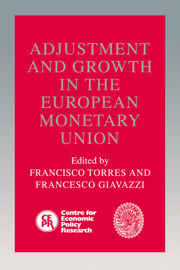Book contents
- Frontmatter
- Contents
- List of figures
- List of tables
- Preface
- List of contributors
- Foreword
- 1 Introduction
- 2 Economic and monetary union: critical notes on the Maastricht Treaty revisions
- Discussion
- 3 The design of optimal fiscal rules for Europe after 1992
- Discussion
- 4 Contracts, credibility and common knowledge: their influence on inflation convergence
- Discussion
- 5 Inflation in fixed exchange regimes: the recent Portuguese experience
- Discussion
- 6 Models of economic integration and localized growth
- Discussion
- 7 Shocking aspects of European monetary integration
- Discussion
- 8 Lessons of Massachusetts for EMU
- Discussion
- 9 Financial and currency integration in the European monetary system: the statistical record
- Discussion
- 10 Currency substitution: from the policy questions to the theory and back
- Discussion
- 11 Coordination of capital income taxes in the economic and monetary union: what needs to be done?
- Discussion
- Index
10 - Currency substitution: from the policy questions to the theory and back
Published online by Cambridge University Press: 29 January 2010
- Frontmatter
- Contents
- List of figures
- List of tables
- Preface
- List of contributors
- Foreword
- 1 Introduction
- 2 Economic and monetary union: critical notes on the Maastricht Treaty revisions
- Discussion
- 3 The design of optimal fiscal rules for Europe after 1992
- Discussion
- 4 Contracts, credibility and common knowledge: their influence on inflation convergence
- Discussion
- 5 Inflation in fixed exchange regimes: the recent Portuguese experience
- Discussion
- 6 Models of economic integration and localized growth
- Discussion
- 7 Shocking aspects of European monetary integration
- Discussion
- 8 Lessons of Massachusetts for EMU
- Discussion
- 9 Financial and currency integration in the European monetary system: the statistical record
- Discussion
- 10 Currency substitution: from the policy questions to the theory and back
- Discussion
- 11 Coordination of capital income taxes in the economic and monetary union: what needs to be done?
- Discussion
- Index
Summary
Introduction: from the policy questions to the theory
In Europe the issue of currency substitution has surfaced in the debate on monetary policy and economic and monetary union (EMU). The main concern is that the liberalization of financial and goods markets can bring about instabilities in money demand with undesirable side effects.
The removal of capital controls has eliminated restrictions on holdings of liquid assets in foreign currency by the residents of countries in the European Community (EC). A noticeable increase in cross-border deposits, documented for example by Angeloni, Cottarelli and Levy (1991), has accompanied the financial liberalization.
The increase in cross-border deposits raises two separate questions. The first, discussed especially by Angeloni et al., concerns the statistical definition of monetary aggregates. If monetary aggregates used by central banks for policy design and implementation do not include a large and growing stock of cross-border deposits, the control problem of the monetary authorities can be made more difficult. Suppose, for example, that a stable demand relationship exists between the ‘true’ monetary aggregates (which include, in some appropriate way, cross-border deposits) and observable variables. But suppose central banks, in their day-to-day management, use monetary aggregates that do not include cross-border deposits. Then the stability of the aggregate used by central bankers depends on the stability of the stock of cross-border deposits.
- Type
- Chapter
- Information
- Adjustment and Growth in the European Monetary Union , pp. 318 - 338Publisher: Cambridge University PressPrint publication year: 1993

